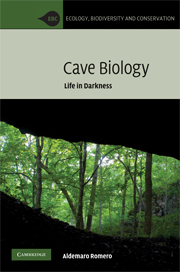Book contents
- Frontmatter
- Contents
- Preface
- Acknowledgments
- 1 A brief history of cave biology
- 2 Cave biodiversity
- 3 The evolutionary biology of cave organisms
- 4 The ecology of cave organisms
- 5 Cave conservation and management
- 6 Epilogue
- Appendix 1 Glossary of terms frequently used in biospeleology
- References
- Index
- Plate section
Appendix 1 - Glossary of terms frequently used in biospeleology
Published online by Cambridge University Press: 21 October 2009
- Frontmatter
- Contents
- Preface
- Acknowledgments
- 1 A brief history of cave biology
- 2 Cave biodiversity
- 3 The evolutionary biology of cave organisms
- 4 The ecology of cave organisms
- 5 Cave conservation and management
- 6 Epilogue
- Appendix 1 Glossary of terms frequently used in biospeleology
- References
- Index
- Plate section
Summary
Some of these terms are purely geological in origin, but they are also employed by biologists. References to the Oxford English Dictionary (OED) are for its electronic edition as per June 2008. Terms in bold within a definition are explained elsewhere in this appendix.
accidental An organism that is rarely found in caves, and when found there, it is not because the organism is making any real use of the habitat. Notice that this is a very ad hoc definition: in theory, when an individual of a species that later may become a permanent inhabitant of caves first enters a cave, it could also be called an ‘accidental.’ This term was introduced in biospeleology by Schiner (1854) and it was later replaced by the term trogloxene by Racovitza (1907). ‘Accidental’ as a term is still utilized, probably as a consequence of applying the terminology of the five classes of association used by the Braun-Blanquet (1928) school of phytosociology (also known as the Zürich–Montpellier School) in the description and classification of plant communities. To Braun-Blanquet, accidentals were rare species in a community, present as chance invaders from another community.
aeolian caves Caves formed by wind erosion. Caves of this type tend to be short in length. They can be found in coastal areas of Oregon State (USA), the American Southwest, the Canary Islands, southern Africa, Israel, and Tasmania.
amphibites Species that require both surface and hypogean waters in order to fulfill their life cycles.
- Type
- Chapter
- Information
- Cave BiologyLife in Darkness, pp. 216 - 226Publisher: Cambridge University PressPrint publication year: 2009

